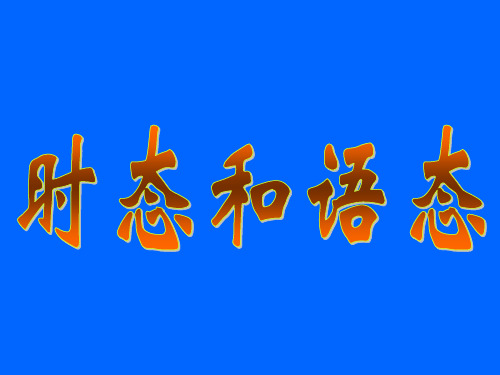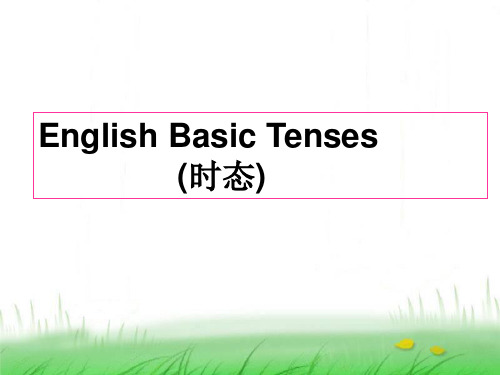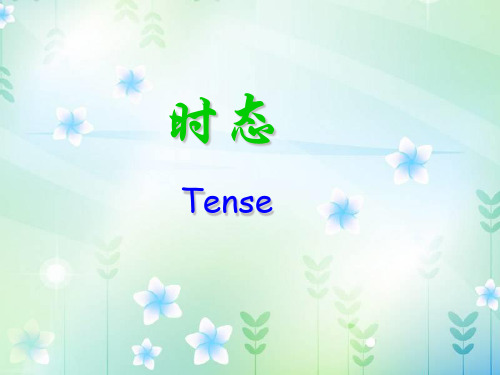高中英语英语时态完整版ppt课件
合集下载
高中英语时态全版.ppt

Tom is seeing his friend off at the airport.
.精品课件.
16
过去进行时 表示过去某一时刻或某一段时间内正在进行 的动作。这一特定的过时间可用时间状语表 示
He was watching TV when I came in.
---What were you doing this time yesterday? ---I was writing a letter.
I will study hard to keep up with my classmates.
He won’t do it.
You shall have the book.
.精品课件.
8
2.be going to + 动词原形:含有打算、计划、 准备将做某事的意思,或表示很有可能要发 生的事。
3.若表示已安排或计划好的将来动作或存 在状态,可用一般现在时代替一般将来 时,其谓语动词常为be, come, go, arrive, leave, start等
Where shall we meet tomorrow?
.精品课件.
7
注:shall和will除了上述表示单纯的将来外, 还有其他用法。在第一人称后,will常表示 “决心”、“意愿”或“打算”,在否定
句中用于所有人称,有“不愿”的意思。 shall用于第二人称时,可表示说明者的将 来意愿或允诺。
the window.)
.精品课件.
4
7. 由here, there开头的句子,动词 用一般现在时表示正在发生的动 作。如:
There goes the bell.
Here comes the teacher.
高中英语语法时态和语态课件(共69张PPT)

不能用 be+v-ing, be+v-ing表示将来,主要强调已经 作出的 安排,e.g. i’m pic you up at 6:00,don’t forget. ) ②强调某个意图是事先考虑好的:
--ann is in hospital.
--yes, i know. i’m going to visit her tomorrow.
--oh,really? i didn’t know. i’ll go and visit her. 2〕表示迹象表明要发生某事,则只能用be going to,e.g.
look at the dark clouds.it’s going to rain. 3〕be going to还有以下用法,e.g. ①强调主观想法或意图: i’m going to wash the car if i have time. (注意:此时
②It was then a small fishing village.
2.特别用法:
1〕表客气或委婉的现在:
①I wondered if you were free this evening.
②I thought you might like some flowers.
(注:过去进行时也可表示现在使语气更委婉、客气,eg.① I was wondering if you could give me a lift. ②We were hoping you would stay with us.能这样用的动 词主要限于want, wonder , think, hope, intend等少数 动词。)
②Someone has broken the window.(结果: 窗户仍破 着)
2〕持续性用法:该用法表示一个过去发生的动作在过去 并未在过去完成,而是持续到现在,且可能继续持续下去 或可能到此结束,e.g.
--ann is in hospital.
--yes, i know. i’m going to visit her tomorrow.
--oh,really? i didn’t know. i’ll go and visit her. 2〕表示迹象表明要发生某事,则只能用be going to,e.g.
look at the dark clouds.it’s going to rain. 3〕be going to还有以下用法,e.g. ①强调主观想法或意图: i’m going to wash the car if i have time. (注意:此时
②It was then a small fishing village.
2.特别用法:
1〕表客气或委婉的现在:
①I wondered if you were free this evening.
②I thought you might like some flowers.
(注:过去进行时也可表示现在使语气更委婉、客气,eg.① I was wondering if you could give me a lift. ②We were hoping you would stay with us.能这样用的动 词主要限于want, wonder , think, hope, intend等少数 动词。)
②Someone has broken the window.(结果: 窗户仍破 着)
2〕持续性用法:该用法表示一个过去发生的动作在过去 并未在过去完成,而是持续到现在,且可能继续持续下去 或可能到此结束,e.g.
高中英语英语时态完整版 PPT课件 图文

英语的时态
一、一般现在时
一直以来的习惯动作;目前状态;规律
一般现在时
单三人称:动词 s或es 非单三人称:动词原形
动词第三人称单数的变化规则
1、直接在动词后+s
like- likes
play-plays
2、以s, x, sh, ch, 接尾的动词:+es
wash-washes
3、以辅音+o接尾的动词:+es
go-goes
4、以辅音+y接尾的动词:变y为i+es
fly-flies
一、一般现在时的用法
1) 经常性或习惯性的动作,常与表示频度的时间状 语everyday, often, always, once a week, seldom, usually等连用。
I leave home for school at 7 every morning. He cycles to work every day. 2) 客观真理,客观存在,科学事实。 The earth moves around the sun. Shanghai lies in the east of China. Water boils at 100 centigrade degrees.
一、基本概念:
过去将来时表示从过去的某一时间看将要发生的动作或存在的状态。 它是一个相对的时态,即立足于过去某时,从过去的某一时间看即 将发生的事情就要用这一时态。 1) He said his mother would buy a bike for him 2) My brother told me he wouldn’t believe Jack any more. 3) Would it be all right if he knew his illness?
一、一般现在时
一直以来的习惯动作;目前状态;规律
一般现在时
单三人称:动词 s或es 非单三人称:动词原形
动词第三人称单数的变化规则
1、直接在动词后+s
like- likes
play-plays
2、以s, x, sh, ch, 接尾的动词:+es
wash-washes
3、以辅音+o接尾的动词:+es
go-goes
4、以辅音+y接尾的动词:变y为i+es
fly-flies
一、一般现在时的用法
1) 经常性或习惯性的动作,常与表示频度的时间状 语everyday, often, always, once a week, seldom, usually等连用。
I leave home for school at 7 every morning. He cycles to work every day. 2) 客观真理,客观存在,科学事实。 The earth moves around the sun. Shanghai lies in the east of China. Water boils at 100 centigrade degrees.
一、基本概念:
过去将来时表示从过去的某一时间看将要发生的动作或存在的状态。 它是一个相对的时态,即立足于过去某时,从过去的某一时间看即 将发生的事情就要用这一时态。 1) He said his mother would buy a bike for him 2) My brother told me he wouldn’t believe Jack any more. 3) Would it be all right if he knew his illness?
高考英语时态总结-全PPT课件

常与频率副词连用 7大频率副词: always,usually,often,sometimes,once,seldo m,rarely,hardly ever,never
完 成
完成 进行
现在完成时 过去完成时
.
21
时间 状态 基本结构
一 般
现在
过去
将来
过去将来
一般现在时
一般过去时
一般将来时 过去将来时
进 行
现在进行时 过去进行时
完 成
完成 进行
现在完成 时 过去完成时
.
22
最常用的几种时态与时间状语的搭配
一般现在 every …, sometimes, at …, on Sunday
过去
现在
过去将来
.
6
时态表示的4种状态
一般-----经常性的动作、状态;一次性的动作。 经常性的动作: I sing English songs every day. 经常性的状态: We love China. 一次性的动作: They climbed up the mountain.
.
7
时态表示的4种状态
.
25
I saw Hero last year. (看《英雄》的时间是去年,与现在无关) I have seen Hero before. (强调现在知道这部电影的内容。以前看过,但 “以前”是表示一个与现在有联系的过去时间, 而 不是一个确定的与现在无关的过去时间) 2.一般过去时和过去完成时的用法区别 (1)一般过去时是对现在说话时刻而言的,过去完 成时则是对过去某一时刻而言。两种时态建立的时间 参照点不同,对过去完成时来说,这个时间参照点十 分重要,它是过去完成概念. 赖以建立的基础,也是和 26
完 成
完成 进行
现在完成时 过去完成时
.
21
时间 状态 基本结构
一 般
现在
过去
将来
过去将来
一般现在时
一般过去时
一般将来时 过去将来时
进 行
现在进行时 过去进行时
完 成
完成 进行
现在完成 时 过去完成时
.
22
最常用的几种时态与时间状语的搭配
一般现在 every …, sometimes, at …, on Sunday
过去
现在
过去将来
.
6
时态表示的4种状态
一般-----经常性的动作、状态;一次性的动作。 经常性的动作: I sing English songs every day. 经常性的状态: We love China. 一次性的动作: They climbed up the mountain.
.
7
时态表示的4种状态
.
25
I saw Hero last year. (看《英雄》的时间是去年,与现在无关) I have seen Hero before. (强调现在知道这部电影的内容。以前看过,但 “以前”是表示一个与现在有联系的过去时间, 而 不是一个确定的与现在无关的过去时间) 2.一般过去时和过去完成时的用法区别 (1)一般过去时是对现在说话时刻而言的,过去完 成时则是对过去某一时刻而言。两种时态建立的时间 参照点不同,对过去完成时来说,这个时间参照点十 分重要,它是过去完成概念. 赖以建立的基础,也是和 26
高中英语语法 动词的时态、语态(共37张ppt)

❶表示在确定的过去时间里所发生的动作或存在的状态,常有表示过去时间的状语,或
有上下文暗示;还可表示 表示在过去一段时间内,经常性或习惯性的动作。
❷在时间、条件、让步状语从句中,若主句用了过去将来时,从句常用一般过去时表示
过去将来的意义。
❸有些动作发生的时间没有具体表明,但实际上是‘刚才,刚刚”发生,或者是表示说话人
1
问题诊断
2020/6/26
2
Ⅰ. 单句语法填空
1. Diets have changed in China—and so too has its top crop. Since 2011,the
country _h__a_s_g_r_o_w__n__ (grow) more corn than rice.(2018·全国卷Ⅱ)
were
2. It was Monday morning,and the writing class had just begin. (2018·全国卷Ⅲ)
begun
3.I had grown not only physically,but also mentally in the past few
I am going to buy some books with my sister this afternoon. 我打算下午和姐姐去买些书。 Look at the clouds. It is going to rain. 看那些乌云。天要下雨了。
2020/6/26
13
三、一般将来时
3 be to +动词原形, 表示按计划进行的动作或征求对方意见。还可 表示吩咐、命令、禁止、可能性等。
会20议20/6/2将6 于今天下午3点举行。
高中英语时态解析 PPT课件 图文

You are to regret for what you did just now.
现在进行时 动词-ing变化规则
一般情况
在词尾直接加-ing
以不发音的e结尾的动词 去e再加-ing 以重读闭音节结尾,且末
双写该辅音字母再加-ing 尾只有一个辅音字母
以-ie结尾的动词
变ie为y再加-ing
have been doing
过去将来时 would do 助动词would
句 子 的 核 心
各种时态的常见用法 一般现在时 一般现在时三单变化规则
一般情况 结尾为-s,-x,-sh,-ch或-o 结尾为“辅音字母+y”
直接加-s 在词尾加-es 变y为i再加-es
用
法
1)表示经常或习惯性的动作,句子中常有 often, always, from time to time 等时间状语。 2)表示主语目前的性格、特征、状态或能力等。 3)表示客观真理、科学事实及自然现象,或用在格言中。 4)一般现在时代替一般将来时。 (1)在时间、条件、让步状语从句中表示将来的动作或状态,可 用一般现在时代替一般将来时,主句仍用一般将来时。
分析成分,翻译句子 1. If you have a kid with special needs in the school system, chances are (that) you’ve come across that saying hanging on a classroom wall. 2. We’ve recently started our day by remindking each other of the good qualities we all possess. 3. These days, shoppers can find products with bac’n, wyngz and a host of other artificial spellings for artificial foods.
现在进行时 动词-ing变化规则
一般情况
在词尾直接加-ing
以不发音的e结尾的动词 去e再加-ing 以重读闭音节结尾,且末
双写该辅音字母再加-ing 尾只有一个辅音字母
以-ie结尾的动词
变ie为y再加-ing
have been doing
过去将来时 would do 助动词would
句 子 的 核 心
各种时态的常见用法 一般现在时 一般现在时三单变化规则
一般情况 结尾为-s,-x,-sh,-ch或-o 结尾为“辅音字母+y”
直接加-s 在词尾加-es 变y为i再加-es
用
法
1)表示经常或习惯性的动作,句子中常有 often, always, from time to time 等时间状语。 2)表示主语目前的性格、特征、状态或能力等。 3)表示客观真理、科学事实及自然现象,或用在格言中。 4)一般现在时代替一般将来时。 (1)在时间、条件、让步状语从句中表示将来的动作或状态,可 用一般现在时代替一般将来时,主句仍用一般将来时。
分析成分,翻译句子 1. If you have a kid with special needs in the school system, chances are (that) you’ve come across that saying hanging on a classroom wall. 2. We’ve recently started our day by remindking each other of the good qualities we all possess. 3. These days, shoppers can find products with bac’n, wyngz and a host of other artificial spellings for artificial foods.
高中英语语法:动词的时态课件(共55张PPT)

之间的一块开阔的草地,只见这只猫又靠近了那儿,并在空中挥舞了
一下前爪。 2020/8/20
13
二、一般过去时
(5)为了使请求更加委婉客气。
I wondered if you’d like to see the film with me tonight.我不
知道你今晚愿不愿意和我一起去看电影。
Could you help me solve the problem.你能帮我解决这个问
多年足球。(表示过去一段时间内持续的动作。)
注意:延续性动词的一般过去时跟一段时间连用,表示过去某一具体的时间段内
持续的2020/动8/20作或状态。
11
二、一般过去时
(2)语境中的一般过去时,往往表示“刚才,在过去”之意,暗 示现在“已不再这样”。 Oh,how nice of you! I never thought you were going to bring me a gift.噢,你真是太好了!我没想到你会给我送礼物。 I didn’t notice where I was going.我当时没有注意到正往哪儿走。 Oh, it’s you, Mary. I didn’t know you would come.噢,是你啊,玛 丽,我不知道你会来。 (3)在时间和条件状语从句中,代替过去将来时。 Mary said as soon as she arrived there, she would ring me up.玛丽说 她一到达那里就给我打电话。
worry worried担心
try tried尝试
study
studied学习
cry cried哭喊
3.一般过去时的用法
(1)表示过去某一具体时间发生的动作或存在的状态或表示过去经常反复发生
高中英语的十六种时态课件(共42张PPT)

• He worked in that hospital for 8 years.(他曾经 在那家医院工作了8年。)
• He has worked in that hospital for 8 years.(他 已经在那家医院里工作了8年。)
• In hospital 住院 in the hospital 在医院
• 例:Great as Newton was, many of his ideas ___________ today and are being modified by the work of scientists of our time.
• A) are to challenge C) have been challenged • B) may be challenged D) are challenging
• A) didn't sell B) sold • C) haven't sold D) would sell
• 答案是C) haven't sold。
• B) 表示从过去某时刻开始,持续到现在的动作或情况, 并且有可能会继续延续下去。此时经常用延续性动词。时 间状语常用since加一个过去的时间点,或for加一段时间, 或by加一个现在时间。
• 例:The old man would sit on a bench in the quiet park and look at others for hours without doing anything or talking to anybody.(老人过去常常坐在宁静的公园里的一 条长椅上,看着其他的人,一坐就是数个小时,什么也不 干,也不和任何人交谈。)
• Would you mind my sitting here?(您介意 我坐在这里吗?)
• He has worked in that hospital for 8 years.(他 已经在那家医院里工作了8年。)
• In hospital 住院 in the hospital 在医院
• 例:Great as Newton was, many of his ideas ___________ today and are being modified by the work of scientists of our time.
• A) are to challenge C) have been challenged • B) may be challenged D) are challenging
• A) didn't sell B) sold • C) haven't sold D) would sell
• 答案是C) haven't sold。
• B) 表示从过去某时刻开始,持续到现在的动作或情况, 并且有可能会继续延续下去。此时经常用延续性动词。时 间状语常用since加一个过去的时间点,或for加一段时间, 或by加一个现在时间。
• 例:The old man would sit on a bench in the quiet park and look at others for hours without doing anything or talking to anybody.(老人过去常常坐在宁静的公园里的一 条长椅上,看着其他的人,一坐就是数个小时,什么也不 干,也不和任何人交谈。)
• Would you mind my sitting here?(您介意 我坐在这里吗?)
高一英语时态讲解ppt课件.ppt

tomorrow.
(否定句)
Will I/ you/ she/ we/ they watch TV tomorrow?
(一般疑问句)
肯定回答:Yes, I/ you/ she/ we/ they will. 否定回答:No, I/ you/ she/ we/ they will not(won’t).
行 时
肯定:Yes,he/she is. 否定结:构N:o, he/she isn’t.
Sb. +is /are /am + v-ing.(肯定句)
SWb.e+/Tishne’ty//aYroenu’ta/raemwnaottc+hvin-igngT.(V 否no定w句.()肯定句)
IsW/Aer/eT+hSeby./+Yov-uinagr?e(n一’t w般a疑tc问hi句ng)TV now.(否定句) 肯A定re回w答e/t:heYeys/y, osbu. +wisa/tacrhe/inamg .TV now(?一般疑问句)
认识到了贫困户贫困的根本原因,才 能开始 对症下 药,然 后药到 病除。 近年来 国家对 扶贫工 作高度 重视, 已经展 开了“ 精准扶 贫”项 目
一般过去时
I watched TV last night
I watch TV everyday. 一般现在时
I am watching TV now. 现在进行时
一 般
肯定回答: Yes , I/we do. 否定回答:No, I/we don’t现.
He He
/ /
She She
wdoaetcshne’tswTaVtcehveTrVydeavye.r(yd肯ay定. 句()否定句)在时
高中英语全时态详解(共60张ppt)

be going to 有很强的计划性,打算干什么,而will表示谈 话时临时决定的意图,具有临时性和偶然性。
① ----The telephone is ringing. ----I _____ answer it.
√A. will B. am going to C. am to D. am about to
English Basic Tenses (时态)
What do you usually do? 我和Tom吃饭。I usually eat with Tom. What did you do yesterday? 我和Tom吃饭。I ate with Tom. What are you doing now? 我和Tom吃饭。 I am eating with Tom What are you going to do tomorrow? 我和Tom吃饭。I am going to eat with Tom.
四.过去将来时(The past future simple Tense)
1. 用法: 过去将来时表示立足于过去某一 时间看将要发生的动作或存在的状态, 常 用于宾语从句中.
2. 结构: 1) should / would + 动词原形 The boy promised he would work hard. I told my parents I should return early.
导入之五:What are they doing now? They are playing basketball.
五. 现在进行时 be (am, are, is)+ doing
1.表示说话时正在进行而尚未完成的动作或状态 ① I don’t really work here. I’m helping until the new secretary comes. ② Selecting a mobile phone for personal use is no easy task because
高中英语16种英语时态讲解(共43张PPT)

• I have bought a computer and I’m going to learn the computer science.
• Someone is knocking at the door. I’ll go and open it.
8
五、现在进行时态
现在进行时的基本用法
形式: am/is/are + doing
现在进行时的基本用法
用法3: 表示最近的将来一定的安排. 通常含有“计划”, “安排做”之意.
• I am taking a makeup test tomorrow. • — what are you doing on Saturday night?
— I’m doing some shopping with Jane. 用法4: 常与always, forever, continually, constantly 等连用,表示抱怨,厌烦, 不合情理或使人不愉快的事.
一般现在时的基本用法
形式:
do 或does(第三人 称单数)
用法1: 表示经常发生的习惯性的动作或者存在的状态.
• He often goes to the gym.
• I like the rice for dinner.
• He doesn’t work hand.
此用法常与一些表示动作频率的时间副词连用(副词放在be动词之 后, 实义动词之前).
3
二、一般现在时态
一般现在时的基本用法
用法2: 表示不受时间限制的事实陈述或客观性的真理. • The earth moves around the sun. • The sun rises in the east and sets in the west. • Knowledge is power.
• Someone is knocking at the door. I’ll go and open it.
8
五、现在进行时态
现在进行时的基本用法
形式: am/is/are + doing
现在进行时的基本用法
用法3: 表示最近的将来一定的安排. 通常含有“计划”, “安排做”之意.
• I am taking a makeup test tomorrow. • — what are you doing on Saturday night?
— I’m doing some shopping with Jane. 用法4: 常与always, forever, continually, constantly 等连用,表示抱怨,厌烦, 不合情理或使人不愉快的事.
一般现在时的基本用法
形式:
do 或does(第三人 称单数)
用法1: 表示经常发生的习惯性的动作或者存在的状态.
• He often goes to the gym.
• I like the rice for dinner.
• He doesn’t work hand.
此用法常与一些表示动作频率的时间副词连用(副词放在be动词之 后, 实义动词之前).
3
二、一般现在时态
一般现在时的基本用法
用法2: 表示不受时间限制的事实陈述或客观性的真理. • The earth moves around the sun. • The sun rises in the east and sets in the west. • Knowledge is power.
- 1、下载文档前请自行甄别文档内容的完整性,平台不提供额外的编辑、内容补充、找答案等附加服务。
- 2、"仅部分预览"的文档,不可在线预览部分如存在完整性等问题,可反馈申请退款(可完整预览的文档不适用该条件!)。
- 3、如文档侵犯您的权益,请联系客服反馈,我们会尽快为您处理(人工客服工作时间:9:00-18:30)。
( B )3. The twins(双胞胎)_____in Dalian last year. They_____here now.
A. are; were
B. were; are
C. was; are
D. were; was
.
( A )4.____your father at work the day_____yesterday﹖
go-goes
4、以辅音+y接尾的动词:变y为i+es
fly-flies
.
一、一般现在时的用法
1) 经常性或习惯性的动作,常与表示频度的时间状语 everyday, often, always, once a week, seldom, usually 等连用。
I leave home for school at 7 every morning. He cycles to work every day. 2) 客观真理,客观存在,科学事实。 The earth moves around the sun. Shanghai lies in the east of China. Water boils at 100 centigrade degrees.
A. Was; before
B. Is; before
C. Was; after
D. Is; after
( B )5. —Who was on duty(值日) last Friday﹖ —_______.
A. I am
B. I was
C. Yes, I was
D. No, I wasn't
.
三、一般将来时
1982等。 I saw Tom in the street yesterday. I bought this TV set in Beijing last year.
2)表示在过去一段时间内,经常性或习惯性的动作。 When I was a child, I often played football in the street. He always went to work by bus.
.
动词过去式的变化(不规则动词)
例: go → went drink → drank eat → ate see → saw
.
spend go am/ is are begin meet write build buy can have/has
spent
went was were began met wrote built bought could had
will do 将要发生、意志决心、临时
一般将来时
.
动词过去式的变化(规则动词)
▪ 以重读闭音节结尾的,则双写
plan → planned e.g. We planned to go to the party.
▪ 以辅音字母 y 结尾,去 y 变 i 加 ed。 如 try → tried; study → studied e.g. He tried to climb the tree, but he could not.
school. 6)Five plus two ______m_a_k__e_s(make) seven. 7)They all ______li_k_e___ (like) him. 8)The sun ______fa_l_l_s__ (.fall) in the west.
二、一般过去时 ——过去动作、过去习惯、过去状态 一般过去时
不规则动词表
leave take catch come do swim drink drive eat get see
.
left took caught came did swam drank drove
ate got saw
二、一般过去时的用法
1)在确定的过去时间里所发生的动作或存在的状态。 时间状语有:yesterday, last week, an hour ago, the other day, in
.
动词过去式的变化(规则动词)
▪ 一般在词尾加 ed ask → asked; help → helped e.g. They asked me the time just now.
▪ 以 e 结尾直接加 d arrive → arrived e.g. I arrived late this morning.
.
一、单项选择:
( C )1. My father_______ill(生病的) yesterday.
A. isn‘t B. aren’t C. wasn‘t D. weren’t
( D )2. _______your parents at home last week﹖
A. Is B. Was C. Are D. Were
.
3) 表示格言或警句中。 Failure is the mother of success. 失败是成功之母。
4) 现在时刻的状态、能力、性格、个性。 I don't want so much. Ann Wang writes good English but does not speak well.
.
• 写出下列动词在句中的适当形式:
1)We ____lo_v__e____ (love) sports. 2)She ____s_i_n_g_s___ (sing) well. 3)Tom and John ______w_a_t_c_h_ (watch) TV
every evening. 4)My son _____g_o_e_s___ (go) to school by bike. 5)Their teacher usually ________w_a_l_k(swalk) to
英语的时态
.
一、一般现在时
一直以来的习惯动作;目前状态;规律
一般现在时
单三人称:动词 s或es 非单三人称:动词原形
.
动词第三人称单数的变化规则
1、直接在动词后+s
like- likes
play-plays
2、以s, x, sh, ch, 接尾的o接尾的动词:+es
